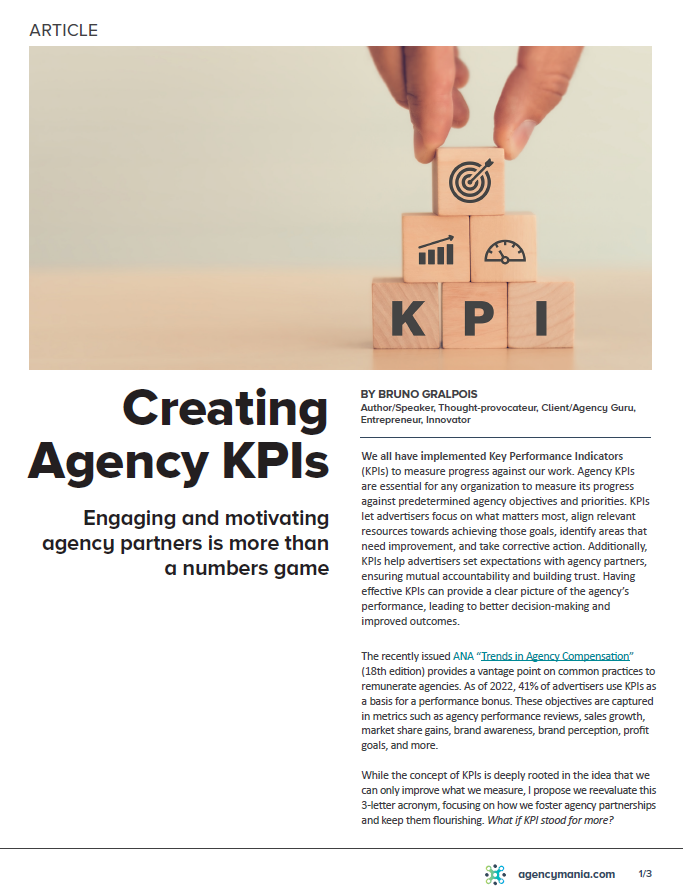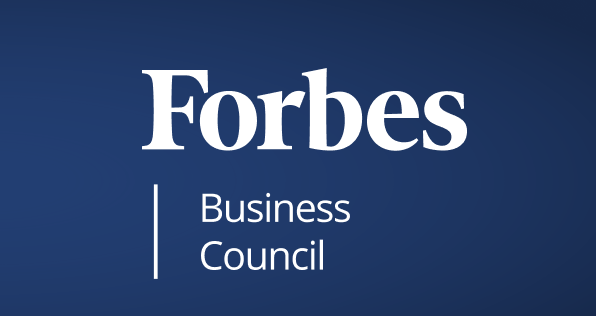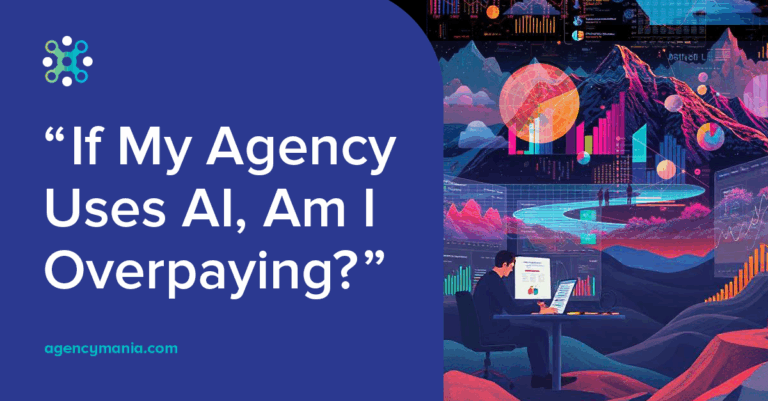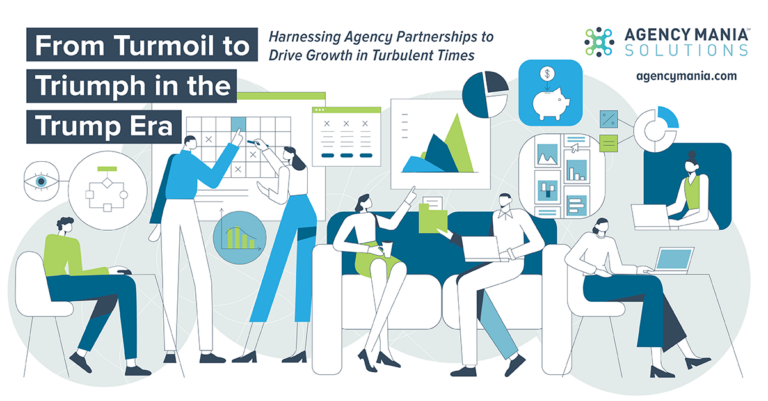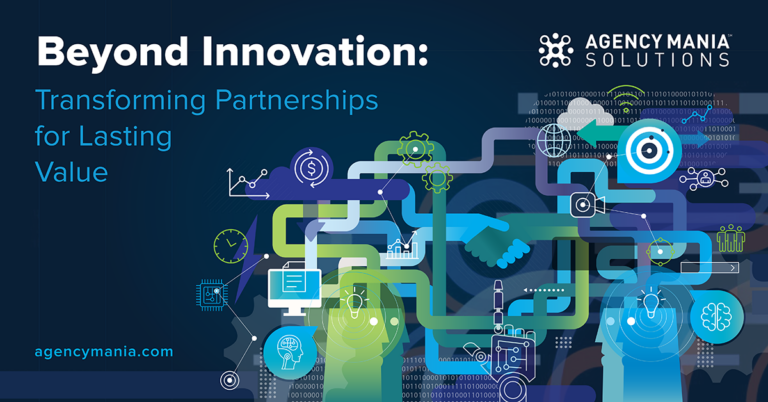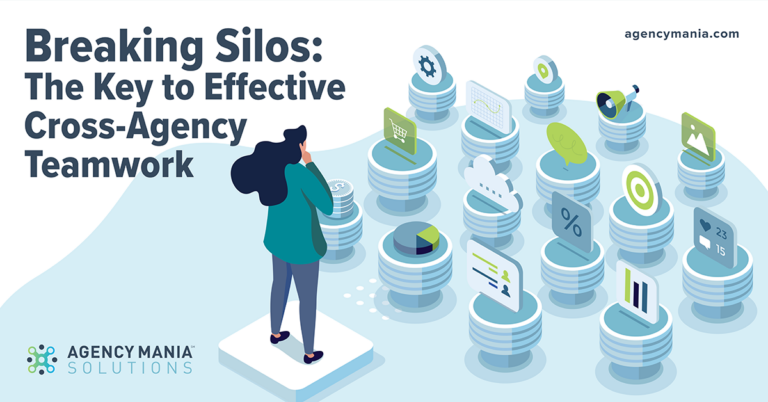Engaging and motivating agency partners is more than a numbers game.
We all have implemented Key Performance Indicators (KPIs) to measure progress against our work. Agency KPIs are essential for any organization to measure its progress against predetermined agency objectives and priorities. KPIs let advertisers focus on what matters most, align relevant resources towards achieving those goals, identify areas that need improvement, and take corrective action. Additionally, KPIs help advertisers set expectations with agency partners, ensuring mutual accountability and building trust. Having effective KPIs can provide a clear picture of the agency’s performance, leading to better decision-making and improved outcomes.
The recently issued ANA “Trends in Agency Compensation” (18th edition) provides a vantage point on common practices to remunerate agencies. As of 2022, 41% of advertisers use KPIs as a basis for a performance bonus. These objectives are captured in metrics such as agency performance reviews, sales growth, market share gains, brand awareness, brand perception, profit goals, and more.
While the concept of KPIs is deeply rooted in the idea that we can only improve what we measure, I propose we reevaluate this 3-letter acronym, focusing on how we foster agency partnerships and keep them flourishing. What if KPI stood for more?
KPI #1: Keep Partners Informed
Keeping agencies well-informed is essential. If agencies miss the mark due to insufficient information, it can cause significant wasted effort and budget for clients. In thousands of agency performance evaluations over the last decade, our company has identified a consistent agency complaint about the lack of useful, actionable guidance from their clients. Agencies fill in the blanks, making assumptions, which often results in rework. It’s both time-consuming and frustrating for all. While clients understand the benefits of providing guidance, it’s often given a low priority by busy marketing stakeholders. We often see that issue during the annual Scope of Work (SOW) process and client input briefings.
To help simplify this process, two former agency strategists (BetterBriefs) developed “The Best Way for a Client to Brief an Agency” in partnership with the Institute of Practitioners in Advertising (IPA).
KPI #2: Keep Partners Involved
Keeping agency partners involved requires effort, communication, and a willingness to create a true partnership. This means setting clear goals and objectives that align with the partners’ interests and priorities, as well as having them engaged in discussions about the company’s progress and plans. Regular meetings and Quarterly Business Reviews offer a venue for brainstorming ideas, challenging the status quo, building trust, and strengthening relationships. Being proactive about identifying new opportunities for collaboration and growth can keep the partnership dynamic and exciting.
One company clearly doing this is Anheuser-Busch InBev (AB InBev), which Cannes Lions selected as Creative Marketer of the Year for the last two years. Its sustained creative excellence has driven sustainable business growth, which is directly attributable to the company keeping its agencies highly engaged.
KPI #3: Keep Partners Inspired
Brands play a key role in getting agencies excited about their work. Brands inspire agency partners by creating a culture of innovation and collaboration that encourages creativity and new ideas. One key element is fostering an environment where agencies feel empowered to share thoughts and suggestions without fear. Encouraging open dialogue and active listening can generate new perspectives and approaches to driving innovation and growth. Recognizing and rewarding partners for their contributions can also inspire continued engagement and commitment. With a culture of innovation and collaboration, businesses keep their partners inspired and motivated to grow and succeed together.
For example, General Motors recently nominated IPG’s Jack Morton Worldwide, Commonwealth//McCann, and McCann Detroit as 2022 General Motors Suppliers of the Year, for their work driving sustainable innovation and advanced solutions for GM. The inspiration behind this award is IPG’s commitment to several climate action targets including reaching net-zero carbon across their business by 2040.
KPI #4: Keep Partners Interconnected
Keeping business partners interconnected requires clear communication channels and protocols to ensure all agency partners are informed and can collaborate. Joint brainstorming and problem-solving sessions also help foster collaboration and creativity between agencies and clients. Joint metrics for measuring success help ensure that all partners are aligned in terms of goals and objectives. By creating a culture of collaboration that prioritizes communication, respect, and shared purpose, brand advertisers can foster strong, productive relationships with their agencies to drive mutual success.
Agencies play a role in facilitating interconnection among their own networks, putting the client at the center of integrated teams under a single hub. This is what Publicis calls “The Power of One.” This concept also recently prompted Stagwell to combine four agencies within its network under the CP+B banner: MMI, Vitro, and Observatory will combine as CP+B across North America, creating an integrated powerhouse agency with capabilities in paid and performance media and marketing, content and audience insight, and analytics.
KPI #5: Keep Partners Improving
Research from Havas last year revealed an urgent need to transform Client-Agency relationships. The report examines how agencies can become more meaningful, long-term partners. More than half of clients surveyed indicate that their agencies “over promise and under deliver” and half believe there is a disconnect between what is needed and what agencies provide. Keeping agencies improving involves continuously working to enhance the value and quality of the partnership. This requires a commitment to ongoing learning and development and a willingness to receive and provide feedback. Regularly soliciting feedback (commonly twice annually) and actively seeking opportunities for improvement can identify areas for partnership strengthening. Collaborating on joint projects and initiatives also can help partners learn from each other and improve, as well as foster stronger, more productive relationships.
Do you have the right agency KPIs in place? Next time you hear the acronym KPIs, think about the many ways you can derive greater value from your partnership with your agency, beyond the numbers.

